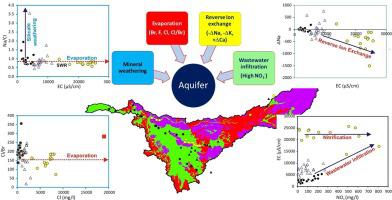Catena ( IF 5.4 ) Pub Date : 2020-08-25 , DOI: 10.1016/j.catena.2020.104864 Natarajan Rajmohan , Milad H.Z. Masoud , Burhan A.M. Niyazi

|
Understanding groundwater salinization and pollution in the arid coastal aquifer is crucial due to complex geochemical processes and sources. This study intends to evaluate the impact of evaporation on groundwater salinity in the arid coastal aquifer, Al Lusub basin, Saudi Arabia using geochemical and multivariate statistical tools. Groundwater samples were collected (n = 52) and analysed for major and minor ions. Groundwater is brackish and shallow wells have higher salinity compared to deeper ones. Hierarchical cluster analysis (HCA) classified the wells into three groups (CG1, CG2, CG3). In these cluster groups, salinity is in the order of CG1(1448 mg/l) < CG2 (3704 mg/l) < CG3(11018 mg/l). PHREEQC modelling reveals that groundwater in this basin is saturated with carbonate, sulphate (CG2, CG3), fluorite (CG3) and silicate minerals, and under-saturated with chloride and hydroxide minerals. Thermodynamic stability diagrams confirm the silicate weathering and kaolinite equilibrium. Precipitation of carbonate minerals at high salinity due to evaporation reduces Ca activity in the groundwater, which triggered the solubility of gypsum and fluorite through common ion effect. Pearson correlation analysis, principal component analysis, ionic ratios (Na/Cl, Cl/Br and F/Cl) and ionic deltas (+ΔBr, +ΔF, +ΔCa, +ΔSO4, +ΔNO3, −ΔNa and −ΔK) justified that non-saline sources and processes, namely evaporation, reverse ion exchange, mineral dissolution and wastewater infiltration predominantly affected the water chemistry in this aquifer. Repeated irrigation practice with high salinity groundwater leads to salt accumulation in the vadose zone due to evaporation, which flushed by the subsequent irrigation events and resulted in higher salinity and NO3− in the groundwater. Hence, sustainable groundwater management and smart irrigation should be implemented.
中文翻译:

蒸发对沙特阿拉伯西部干旱沿海含水层中地下水盐分的影响
由于复杂的地球化学过程和来源,了解干旱沿海含水层中的地下水盐碱化和污染至关重要。这项研究旨在使用地球化学和多元统计工具评估蒸发对沙特阿拉伯铝卢萨盆地干旱沿海含水层中地下水盐度的影响。收集了地下水样品(n = 52)并分析了主要离子和次要离子。与较深的井相比,地下水微咸,浅井的盐度更高。层次聚类分析(HCA)将井分为三类(CG1,CG2,CG3)。在这些簇群中,盐度为CG1(1448 mg / l)<CG2(3704 mg / l)<CG3(11018 mg / l)。PHREEQC模型显示该盆地的地下水充满了碳酸盐,硫酸盐(CG2,CG3),萤石(CG3)和硅酸盐矿物,并被氯化物和氢氧化物矿物饱和。热力学稳定性图证实了硅酸盐的风化作用和高岭石的平衡。蒸发导致高盐度碳酸盐矿物的沉淀降低了地下水中的Ca活性,这通过常见的离子效应触发了石膏和萤石的溶解度。皮尔逊相关分析,主成分分析,离子比(Na / Cl,Cl / Br和F / Cl)和离子δ(+ΔBr,+ΔF,+ΔCa,+ΔSO4,+ΔNO 3,-ΔNa和-ΔK)正当非盐水来源和过程,即蒸发,反向离子交换,矿物溶解和废水浸润主要影响在这个含水层中的水的化学反应。与高盐度地下水导致盐堆积在渗流区由于蒸发,其冲洗通过随后灌溉事件和导致较高盐度和NO重复灌溉实践3 -在地下水。因此,应该实施可持续的地下水管理和智能灌溉。











































 京公网安备 11010802027423号
京公网安备 11010802027423号